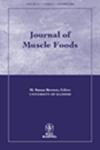EVALUATION OF METAL HYDROXIDE IMMOBILIZATION AND DNA EXTRACTION METHODS ON DETECTION OF SALMONELLA ENTERICA FROM PORK SAUSAGE BY NESTED POLYMERASE CHAIN REACTION
Abstract
ABSTRACT
The aim of this work was to evaluate the effectiveness of metal hydroxide immobilization and five different DNA extraction methods in detection of Salmonella enterica from pork sausage samples by nested polymerase chain reaction (PCR). Immobilization of bacterial cells by Zr(OH)4 and Ti(OH)4 was carried out prior to DNA extraction by five DNA extraction methods. The fliC gene and enterotoxin (stn) gene of Salmonella enterica was amplified by nested PCR. Both metal hydroxide immobilization and nested PCR amplification were able to increase the detection sensitivity. DNA extraction by modified Fontana and Kapperud methods were more effective compared with other methods. The amplification of enterotoxin (stn) gene provided more sensitivity of detection compared with amplification of fliC gene. This study shows that the use of metal hydroxide immobilization and nested PCR are able to increase the sensitivity of Salmonella enterica detection from meat food samples.
PRACTICAL APPLICATION
In this experiment, two extraction methods were found to be more effective for the extraction of DNA from Salmonella enterica-spiked pork sausage. Immobilization of Salmonella cells by metal hydroxide and application of nested polymerase chain reaction were able to increase the detection sensitivity and reduce the possibility of false positive results. These findings are useful in the selection of suitable methods for rapid, sensitive and reliable detection of bacterial pathogens from meat food samples.

 求助内容:
求助内容: 应助结果提醒方式:
应助结果提醒方式:


